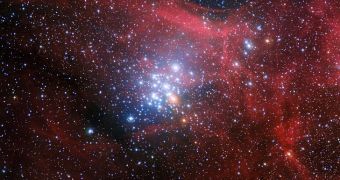Just yesterday, folks at the European Southern Laboratory (ESO) introduced the world to the stunning photo above. The image was obtained with the help of the La Silla Observatory in Chile, and it shows a bunch of juvenile stars cuddling together.
The glowing celestial bodies in this photo are part and parcel of a star cluster estimated to sit at a distance of about 8,000 light-years from our planet. As detailed by ESO researchers, the cluster's official name is NGC 3293.
Astronomers who have taken the time to study it and its makeup say that NGC 3293 comprises not just young stars, but also clouds of gas and dust. In fact, it is believed that, millions of years ago, gas and dust were all that could be found where the cluster now sits.
Investigations have revealed that it was only about 10 million years ago that stars began to form in this part of the universe, and NGC 3293 as we know it came into being. This is the reason the cluster chiefly comprises juvenile stars.
10 million years might sound like a whole lot of time, but, when compared to how old other parts of the universe are, NGC 3293 is basically an infant. Thus, astronomers say that our Sun has been around for 4.6 billion years, and that, despite its age, retirement is nowhere in sight.
Evidence at hand indicates that the stars that make up this cluster all formed from the same cloud of gas and dust, at about the same time and at the same distance from our planet. However, they seem to have evolved differently as time went by.
More precisely, astronomers explain that, whereas some of the stars forming NGC 3293 look and act their age, others look and behave as if they were old souls. Simply put, their appearance and glowing patterns are similar to that of much older stars. This is due to the conditions in which they were born.
“Take the bright orange star at the bottom right of the cluster. This huge star, a red giant, would have been born as one of the biggest and most luminous of its litter, but bright stars burn out fast. As the star used up the fuel at its core its internal dynamics changed and it began to swell and cool, becoming the red giant we now observe.”
“Red giants are reaching the end of their life cycle, but this red giant’s sister stars are still in what is known as the pre-main-sequence — the period before the long, stable, middle period in a star’s life. We see these stars in the prime of their life as hot, bright and white against the red and dusty background,” astronomers explain.
Because of how diverse the stars that make up NGC 3293 are, astronomers expect that, by further studying them, they will be able to gain a better insight into the history of the universe. Specifically, they hope that this cluster can help shed new light on the evolution of stars.

 14 DAY TRIAL //
14 DAY TRIAL //